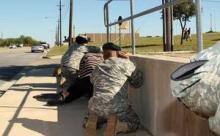BOSTON – A volatile mixture of individual, environmental, and social factors may cause a soldier to explode with anger and aggression toward himself or his fellows in arms, said a psychiatrist who studies suicidal behaviors and homicidal acts among U.S. service members.
"I don’t want to say that every vet is a walking time bomb, but I think you need to be thinking about it all the time," said Dr. Elspeth Cameron Ritchie at a conference on the complexities and challenges of PTSD and TBI, sponsored by Massachusetts General Hospital.
Reviews of mass shootings at bases in the United States and abroad, as well as homicides among soldiers at Fort Carson, Colo., show that many of the factors that are known to heighten risk for violence in the general population are present in the military, with the addition of a key significant factor: ready access to lethal weapons.
"I don’t think it’s a great message when we sell weapons in PXs [post exchanges]. We have had some episodes where people have bought weapons and then shot themselves or another member, sometimes in the PX itself," said Dr. Ritchie, chief clinical officer for the District of Columbia Department of Mental Health and a retired colonel in the U.S. Army.
Army Suicide Rates Rising
Risk factors for suicide and violence toward others in the military population are similar to those seen in civilian life: acute psychosis, insult-evoked reactions, drug and alcohol use/abuse, recent stressors, unstable mood and affect, mania, and severe depression.
Mood and adjustment disorders and substance abuse are relatively common among Army personnel who commit suicide, but more serious psychiatric disorders and personality disorders are less frequent, Dr. Ritchie said. Suicides are often linked to relationship problems, legal or occupational difficulties, and chronic pain and/or disability. Recently, there has been an uptick in suicides among older service members, higher ranks, and women.
Historically, the rates of suicides among active-duty Army members had been lower than that of the general population. But data from the Centers for Disease Control and Prevention’s National Center for Health Statistics shows that while suicide rates among the general population remained flat from 2001 through 2006, the rate among active Army members doubled, and is expected to be about 23/100,000, higher than that of the age- and gender-adjusted rate in the United States of about 18/100,000 when the most recent data (for 2008 and 2009) become available.
A review by the Army’s Epidemiology Consultant Service (EPICON) of suicides and homicides among active-duty soldiers in the United States reveals common themes involving individual and system-related risk factors, including:
• Deployment length, frequency, unpredictability.
• Combat intensity.
• Family separation, relationship stress, lack of support.
• Increased violence against others, including spouse/family.
• Increased drug/alcohol use and related offenses.
• Previous gestures/attempts and/or behavioral health contact.
• Manipulation, malingering.
• Legal/financial troubles.
• History of misconduct.
System-related issues include:
• Stigma: personal, peer, leadership, career.
• Poor service delivery for dependents.
• Transition, reintegration issues.
• Problems with behavioral health services.
• Lack of standardized screening, tracking, intervention or data collection.
• Leadership management/climate.
Cases of Violence at Army Bases
Dr. Ritchie reviewed several well-known and less well-publicized examples of violence at U.S. Army bases over the last decade.
For example, at Fort Bragg, N.C., there were two cases of husbands murdering wives and two husband and wife murder-suicides in 2002. A 12-member Army team reviewed the cases and determined that rapid return from the theater of battle, infidelity, access to weapons ("a gun in the nightstand"), lack of access to care, and perceived stigma were common factors.
Suicides and other acts of violence at Fort Hood, Tex., in 2005 and Fort Campbell, Ky., in 2007 had several key features in common, including high operational tempo, transition in leadership, fragmentation of care, and access to weapons.
And in the most notorious event, an Army psychiatrist at Fort Hood killed 13 people in a deployment clinic on base in 2009. Dr. Ritchie said that in retrospect, many of the previously mentioned red flags were present in that case. Although it led to multiple efforts to screen soldiers for violence, most are unlikely to confess on questionnaires to having violent thoughts, she added.


